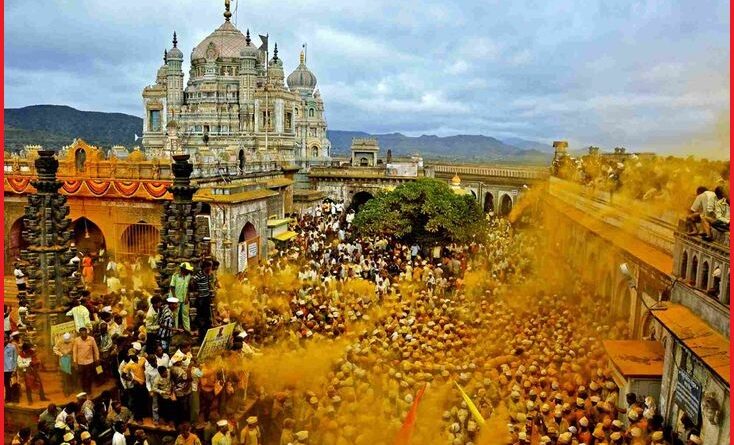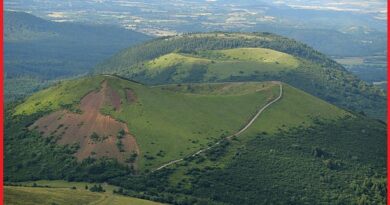Sacred Splendor: Exploring the Mystique of Jejuri Temple
Jejuri Temple
Jejuri Temple, located in the town of Jejuri in the Pune district of Maharashtra, India, is one of the most revered pilgrimage sites dedicated to Lord Khandoba, a popular deity in Maharashtra. The temple is also known as “Khandoba Temple” or “Khandoba Mal” and is situated on a hill, offering a panoramic view of the surrounding area.
The Jejuri Temple has a rich historical background and is considered an important site in the worship of Khandoba, which is a form of Lord Shiva. The Dhangar community and others in Maharashtra and Karnataka particularly revere the deity Khandoba. The temple features traditional Maratha architecture with elaborate stone carvings and sculptures. The steps leading up to the temple are lined with Deepmalas (lamp towers) lit during festivals, creating a stunning visual.
The temple is bustling with devotees throughout the year, with a significant increase during major festivals like Somvati Amavasya, Champa Shashti, and Dasara. During these festivals, special rituals and processions are held, attracting pilgrims from various parts of the state. A unique aspect of the worship at Jejuri Temple is the use of turmeric powder, which is considered holy and is often offered to the deity and smeared on devotees. This gives the temple a distinctive yellow hue during festive times.
Best Time to Visit: The ideal time to visit is during the early morning or late evening to avoid the heat and crowds. Festival times, while crowded, provide a unique and vibrant experience.
Jejuri Temple Timings
- Morning Opening Time: Around 5:00 AM
- Bhupali and Arrti: Around 5:30 AM
- Darshan: Around 6:30 AM
- Night Closing Time: Around 9:00 PM
These timings can vary slightly depending on specific days, festivals, and other factors. It’s always a good idea to verify the current timings either by contacting the temple administration directly or checking their official website or local sources before planning your visit.

Jejuri Temple History
The history of Jejuri Temple is intertwined with the rich cultural and religious heritage of Maharashtra, particularly with the worship of Lord Khandoba, also known as Malhari Martand or Martanda Bhairava. The origins of the Jejuri Temple trace back to ancient times, with the worship of Lord Khandoba believed to have started several centuries ago. Lord Khandoba is a folk deity and a form of Lord Shiva, revered as the “God of Jejuri” and the “God of Palanpur. The exact founding date of the temple is not well-documented, but it is believed to have been established many centuries ago by devotees of Lord Khandoba.
Also read- Pawna Lake: Nature’s Haven Near Pune
Mythological Legend
According to local folklore, Lord Khandoba manifested on the Ratnagiri hills in Jejuri to vanquish the demon Malla and his brother Mani. Legend has it that Lord Khandoba, accompanied by his wife Mhalsa and his devotee Banai, defeated the demon brothers in a fierce battle. The temple is said to have been built at the spot where the battle took place, signifying the triumph of good over evil.
Development and Patronage
Over the centuries, Jejuri Temple has been patronized by various rulers and dynasties that ruled over the region, including the Yadavas, the Bahamanis, the Marathas, and later, the British. These rulers contributed to the temple’s growth and development, leading to the construction of various structures and the enhancement of its religious significance.
Cultural Significance
Jejuri Temple holds immense cultural significance, not only for its religious importance but also for its role in promoting art, music, and literature in Maharashtra. The temple has been a center for bhakti (devotional) poetry, music, and dance forms, with numerous compositions dedicated to Lord Khandoba. The annual festivals and rituals at Jejuri Temple are vibrant celebrations of Maharashtra’s cultural heritage, attracting devotees and tourists from far and wide.
The history of Jejuri Temple is a testament to the enduring devotion and cultural vibrancy of Maharashtra, and it continues to be a cherished pilgrimage destination for millions of devotees seeking blessings and spiritual solace.
How to Reach Jejuri Temple
The nearest major airport to Jejuri is Pune International Airport, which is well-connected to major cities in India as well as some international destinations. From Pune Airport, you can hire a taxi or use other modes of transportation to reach Jejuri, which is about 50 kilometers away
From Pune: Jejuri is approximately 50 kilometers from Pune city. You can take a private car, taxi, or use app-based cab services to reach Jejuri. The journey takes around 1.5 to 2 hours, depending on traffic conditions. From Mumbai: If you’re traveling from Mumbai, you can take the Mumbai-Pune Expressway and then proceed towards Jejuri via Pune. The distance is around 200 kilometers, and the journey takes about 4 to 5 hours by road.
By Train- The nearest railway station to Jejuri is the Jejuri Railway Station itself, which is well-connected to major cities like Pune, Mumbai, and Satara. From Pune, you can board a train to Jejuri Railway Station, and from there, Jejuri Temple is a short distance away. However, please note that not all trains may stop at Jejuri, so it’s essential to check the schedule beforehand.



